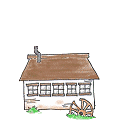Here are some ideas I've been contemplating and information sources I've been learning from.
While researching ancient buildings that endured various natural disasters for many centuries and remain intact, what appeals to me most so far are thick adobe, stone, or cob walls (suitability depends on area and intended use) with basalt reinforcements to create stabilized earthen walls. Thick walls of course will require much more intensive labor and time, but I feel the end result will be worthwhile.
Most of my ideas have no less than 3' thick walls, and I am inclined toward domes (360 degree arch support) with 5' thick walls at the foundation that decrease to about 3' at the roof - all of which will be reinforced with stabilized earth using basalt fabric about every foot from within the foundation to the top. The idea is if a freak gust of wind drops a large tree on the top, little to nothing happens. As ideas firm up, I'll be asking for help to determine an optimal distance between layers of basalt fabric in layers of cob (my choice so far).
I feel high, narrow, dormer-type windows are important and I've chosen hurricane glass. The walls will be thick enough that the dormers can be inset to prevent wind, rain, and snow from reaching the glass. And the outer area around the dormer windows will be shaped to direct rain and snow most appropriately.
To disturb the ground as little as possible, I am thinking of building a small shelter in ground, then building the rest of the home upward and surrounded by terracing and hugelkulturs as protection from wind, to both draw moisture away from the home while utilizing snow and rain for the food forest planned on and around the hugelkulturs, and for privacy. (The
earthworks come first and the land determines those, however I need to have an idea of what the home is about to plan around it.) (Also planning a large-ish pond as water source, a way to bring water into the home what is not easily detectable from outside, and perhaps a separate small, sealed saltwater pond to create electricity without being on a short leash with solar.)
So far I am avoiding certain cements because breathability is a must to remain healthy and not create a sick building. I am still studying breathable plasters and ways to protect a roof and walls from moisture.
While I don't perceive myself to be a prepper, I do have immense respect for the elements and nature's curveballs. I also figure staying safe requires choosing an area in which the worst of human nature is most likely avoidable. That said, to satisfy curiosity about weathering stray bullets from hunters, I found some youtube videos that demonstrated what kind of bullets go how deep in various materials and wall thickness. I would post those links, but considerations most likely vary with individual concerns.
There are numerous other considerations, but this post is most focused on feeling safe and avoiding natural and human-related catastrophes.
Here's are some information sources I've researched specific to basalt rebar / rope / mesh / fabric. A few months ago the pricing seemed reasonable, while stronger and less expensive than steel, more environmentally friendly, and does not attract condensation as metal does because basalt is glass. Here are some links and permies posts that helped me begin exploring options.
https://www.forconstructionpros.com/concrete/equipment-products/article/12184173/basalt-fiber-reinforced-rebar
https://www.youtube.com/watch?v=N18HcPfKv1E
https://basalt-rebar.com/
https://basalt-mesh.com/
http://compositegroupworld.com/produktsiya/bazaltoplastikovaya-armatura.html
https://permies.com/t/56449/Banding-Strapping-Bond-Beam#473854
https://permies.com/t/48696/Building-interior-cob-wall-concrete#390625
https://permies.com/t/119954/Building-Tornado-Resistant-House





 2
2




 1
1








 3
3




 1
1

















 1
1















